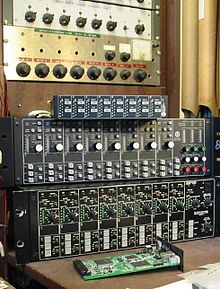- Dan Dugan (audio engineer)
-
For other people of the same name, see Dan Dugan.
Dan Dugan 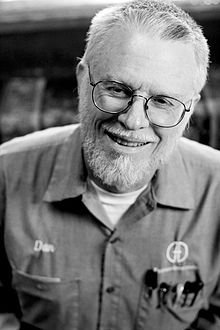
Born March 20, 1943
Los Angeles, California, USAResidence San Francisco, California Other names Daniel W. Dugan Occupation Audio engineer, inventor, sound designer, nature recordist Website http://www.dandugan.com/ Dan Dugan (born March 20, 1943) is an American audio engineer, inventor, and nature sounds recordist. He was the first person to be called a sound designer, and he developed the first effective automatic microphone mixer: the automixer.
Contents
Early career
Daniel W. Dugan was born in Los Angeles, California, on March 20, 1943, after his father had shipped out to the Pacific War. (Two months later, U.S. Navy Commander P. F. Dugan took command of the attack transport USS Doyen, and led her in support of five invasion operations.[1]) "Dan" Dugan was raised in San Diego, California, where his parents took him to the Old Globe Theatre and summer musicals at the Ford Bowl—he always wanted to go backstage to see the lighting control console. As a young man he sang bass in the church choir, in the San Diego Bach Chorus, in choral workshops under Roger Wagner at San Diego State University, and in madrigal groups for Dancing on the Green. Dugan obtained a four-year scholarship to the University of San Francisco and majored in physics and math.[2] He dropped out in 1963 to pursue stagecraft, specifically lighting design.[2] His early lighting designs include ones for the San Diego National Shakespeare Festival at the Old Globe Theatre, the San Diego Opera, and the Actor's Workshop in San Francisco.[3]
Sound design
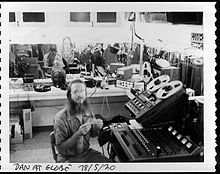 1978: Dugan prepares sound design materials in a dressing room at the Old Globe Theatre in San Diego
1978: Dugan prepares sound design materials in a dressing room at the Old Globe Theatre in San Diego
Dugan changed from lighting design to sound design in 1967. He designed sound for the Shakespeare festival in San Diego and for the American Conservatory Theatre (ACT) in San Francisco.[3] Dugan's complex and atmospheric theatrical sound solutions led to a new title: during ACT's 1968–69 season, he was the first person to be called a "sound designer".[4] He presented a paper about his sound design to the Audio Engineering Society (AES) at their 37th convention, and his paper was published in their Journal in December 1969.[5] Dugan described a system in which the signals from three stereo tape players were routed to ten loudspeaker zones in the theater.[5]
Dugan designed sound for three regional productions of Hair, the musical: ones in Chicago, Las Vegas and Toronto.[2] The Chicago production ran in 1969 and 1970 at the Blackstone Theatre, operated at that time by The Shubert Organization.[6] Dugan was able to design sound but not allowed to operate the mixing console because he was not in the stagehands union: International Alliance of Theatrical Stage Employees (IATSE).[2]
When Margrit Mondavi founded the Mondavi Summer Music Festival in 1969 at the Robert Mondavi Winery, primarily featuring jazz artists, Dugan mixed sound for many seasons.[3] As well, he recorded independent record albums, including Kate Wolf's first two: Back Roads (1976) and Lines on the Paper (1977).[3] He designed sound for the Sacramento Music Circus.[7]
Automixer
While designing sound for the musical Hair, Dugan began to appreciate the problem of a human operator not being fast enough to control multiple microphones.[8] He saw the show's audio mixing person "working rotary knobs for 16 area mics, 9 hand mics, and 10 mics in the band".[8] Dugan thought that a microphone should not be on unless it was getting some worthwhile signal, more than just the room ambiance. His frustration with microphone mixing[7] led him to experiment for a few years, finally developing the "Dugan Music System", shown to the AES at their 49th convention, held in New York in 1974.[9] This system used a novel proportional gain algorithm whereby the total gain was divided between all active microphones. The microphones were "continuously and automatically adjusted" to bring them up or down in the mix, based on how much signal they were sending relative to the signal received by a reference microphone placed somewhat distant from the other microphones.[10] Dugan's patent application for a "Control Apparatus for Sound Reinforcement Systems" was accepted and published on June 4, 1974.[10] This was the first useful automatic microphone mixing algorithm,[11] the basis for all of Dugan's later systems.[12][13]
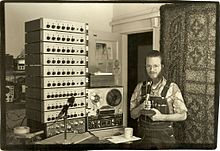 Dugan tests nine Model A automixers, ca. 1980
Dugan tests nine Model A automixers, ca. 1980
Though the algorithm was good, the reference microphone was an unpredictable variable: it had practical placement problems. If it was near the audience, audience noise would skew the algorithm. If placed backstage, crew and equipment noises could be a factor. Thus, the Dugan Music System was not immediately developed into a product. Dugan studied the problem, researching alternative solutions. In 1975, Dugan filed a patent for the "Dugan Speech System",[14] and in 1976 produced 60 copies of what he named the Dugan Model A. The automixer with serial number 1, a unit Dugan fabricated by hand, "was installed in the conference room of Bell Labs by Harvey Fletcher".[7] Significantly, the external microphone reference of the Dugan Music System was replaced by a reference composed of the total signal received from all of the active microphones. Dugan described the process some three decades later:
"I was messing around with logarithmic level detection, seeing what would happen if I used the sum of all the inputs as a reference. That's when I accidentally came upon the system. It was really discovered, not invented. I didn't really know what I had, just that it worked like gangbusters."[2] Dugan holds his Yamaha Dugan-MY16 card (2011), and to his left are earlier automixer models
Dugan holds his Yamaha Dugan-MY16 card (2011), and to his left are earlier automixer models
Dugan licensed this more practical system to Altec who produced 4- and 8-channel automixers for commercial installations such as hotels, conference rooms, courtrooms and city council chambers. The Dugan Speech System was the first commercially successful automixing algorithm.[12] Over the next 15 years, other manufacturers designed competing automixers, and the market segment was born.[2]
In the late 1980s, Dugan developed a gain-limiting improvement to the automixing algorithm. The Dugan Gain Limiting System was patented in September 1989[15] and presented to the 87th AES convention in October.[16] Dugan described for the AES his prototype of an automixer to be inserted into selected microphone channels of a mixing console, operated by a person, to help in mixing multiple live microphones to have less reverberation and noise, more focus on the desired sound, eliminating the mixing engineer's problem of too-slow human reaction time.[16] The gain limiting system provided smooth, continuous control over the equivalent number of open microphones (NOM) that the automixer would send at its outputs. The NOM could be set anywhere between 1 and 10, with higher settings sounding more natural for a recording in a studio, and lower settings offering greater control of acoustic feedback in the presence of sound reinforcement loudspeakers. An embodiment of Dugan's three patents was produced as the Model D Automatic Mixing Controller, a 3U rack unit handling 8 channels which could be linked with up to 11 other Model Ds to automatically mix as many as 96 channels simultaneously.[17]
Dugan's original 1974 patent expired in 1991, and the Dugan Speech System patent in 1993. Other manufacturers began to sell automixers incorporating the Dugan algorithm.[8] In 1996, Dugan produced the Model D-1, an automixer for speech-only applications. The Model D-2 returned to having applicability for both speech and music, and the Model D-3 as well. In 1997, Dugan licensed his system to Protech Audio of Indian Lake, New York, yielding the Protech 2000 model series.[18]
In September 2006, Dugan produced the Model E, the E standing for economy.[7] This half-rack-sized automixer was much smaller and less expensive than previous ones. It could be linked with another Model E to control up to 16 channels; two units could be mounted side-by-side in only 1U of rack space.[19] The Model E's popularity came with many critical requests for features, and in May 2008 the Model E-1 was introduced; an incremental improvement to replace the Model E.[20] It allowed ADAT Lightpipe interconnections between linked units and a digital mixing console, helpful with Yamaha, Mackie and other digital audio gear containing ADAT inputs and outputs. Its user interface was a simple web browser page, accessible by computer connected with Category 5 cable.[21]
In February 2011, Dugan demonstrated an automixer card, marketed by Yamaha, to plug in to the accessory slot of a Yamaha digital mixer such as the LS9, M7CL or PM5D. This card, the Dugan-MY16, could mix up to 16 channels of microphone inputs, assigned to selected inserts in the mixer's graphic user interface. Like the Model E-1, the automixer could be adjusted through a web browser interface, allowing remote control with an iPad, touchscreen computer or laptop over wireless network.[22]
Nature sounds
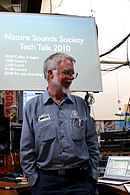 Hosting a "Tech Talk" for nature sounds recordists
Hosting a "Tech Talk" for nature sounds recordists
Dugan made his first sound effects recordings to augment his theatrical sound designs. As he grew more interested in field recording, he was attracted to the sounds found in pristine natural settings—environments without human noise. A board member and webmaster of Nature Sounds Society, Dugan has conducted equipment training sessions since 1994,[23] and has given talks about his experiences in nature recording. He has traveled to New Zealand in pursuit of recordings, but mainly devotes himself to U.S. National Parks and Monuments such as Yosemite and Muir Woods.[24] Other national parks and monuments at which he has recorded sound include Joshua Tree, Pinnacles, Lassen Volcanic, Yellowstone, Haleakala, Olympic, Zion, Bryce Canyon, Kings Canyon, Sequoia and Lava Beds.[24]
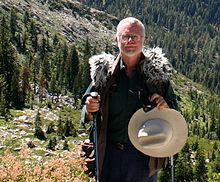 Recording in the field wearing a vest with attached microphones protected by furry windscreens
Recording in the field wearing a vest with attached microphones protected by furry windscreens
Dugan and his wife Sharon Perry, Nature Sounds Society chair, recorded the dawn chorus of Cathedral Grove in Muir Woods once each month for a year.[24] He has partnered with the National Park Service and the California Library of Natural Sounds to document the various sounds heard in U.S. parks. Regarding his reasons for doing so, Dugan wrote in 2008:
"There are three potential values in soundscape recording in a National Park. Scientific, to document the biophony at that place and time. Political, to document the anthrophony, collecting evidence that might be useful in policy-making about aircraft and visitor traffic. Artistic, to use in natural sound compositions."[25]In 2006, Dugan assisted a group of researchers studying soundscapes and human use at Muir Woods. The researchers presented their findings at the Northeastern Recreation Research Symposium, produced by the United States Forest Service, a work titled, "From Landscapes to Soundscapes: Understanding and Managing Natural Quiet in the National Parks".[26] They concluded that human-generated noise "is a potentially important indicator of quality" of soundscapes in parks.[26]
References
- ^ Priolo, Gary P.. "USS Doyen (APA-1)". NavSource Online: Amphibious Photo Archive. NavSource Naval History. http://www.navsource.org/archives/10/03/03001.htm. Retrieved March 25, 2011.
- ^ a b c d e f Kontney, Jack (May 1, 2006). "AV Industry Icons: Dan Dugan". Sound & Video Contractor. Penton Media. http://svconline.com/loudspeakers/features/avinstall_av_industry_icons/. Retrieved March 22, 2011.
- ^ a b c d "Dan's Personal Page". Dan Dugan Sound Design. http://www.dandugan.com/personal/personal.html. Retrieved March 22, 2011.
- ^ Kaye, Deena; LeBrecht, James (2009). Sound and music for the theatre: the art and technique of design. Focal Press. p. 8. ISBN 0240810112. http://books.google.com/books?id=l2gHgjAjGPYC&pg=PT31.
- ^ a b Dugan, Dan (December 1969). "A New Music and Sound Effects System for Theatrical Productions". Journal of the Audio Engineering Society. Audio Engineering Society. pp. 666–670. http://www.aes.org/e-lib/browse.cfm?elib=1540. Retrieved March 23, 2011.
- ^ "A History of the Merle Reskin Theatre". The Theatre School, DePaul University. http://theatreschool.depaul.edu/about_merle_reskin_theatre.php. Retrieved March 22, 2011.
- ^ a b c d Slaton, Shannon (June 1, 2008). "Sound Product Of The Month: Dugan Model E-1 Automatic Mixing Controller". Live Design. Penton Media. http://livedesignonline.com/gear/sound/sound_product_month_3/index.html?imw=Y. Retrieved March 23, 2011.
- ^ a b c Jones, Elaine (March 6, 2009). "Using Automatic Mic Mixers". AV Technology. NewBay Media. http://avtechnologyonline.com/article/26950.aspx. Retrieved March 23, 2011.
- ^ Dugan, Daniel W. (February 1991). "Adaptive Threshold Automatic Microphone Mixing System Becomes Public Domain". AES E-Library. Audio Engineering Society. http://www.aes.org/e-lib/browse.cfm?elib=5643. Retrieved March 23, 2011.
- ^ a b US patent 3814856, Dan Dugan, "Control Apparatus for Sound Reinforcement Systems", issued 1974-06-04
- ^ Ferstler, Howard (2005). Encyclopedia of recorded sound. 1 (2 ed.). CRC Press. p. 54. ISBN 041593835X. http://books.google.com/books?id=xV6tghvO0oMC&pg=PA54.
- ^ a b Eargle, John; Foreman, Chris (2002). Audio engineering for sound reinforcement. Recording and Audio Technology. Hal Leonard Corporation. p. 89. ISBN 0634043552. http://books.google.com/books?id=YWzZe6z4xdAC&pg=PA89.
- ^ Ballou, Glen (2005). Handbook for sound engineers (3 ed.). Focal Press, Gulf Professional Publishing. p. 615. ISBN 0240807588. http://books.google.com/books?id=y0d9VA0lkogC&pg=PA615.
- ^ US patent 3992584, Dan Dugan, "Automatic Microphone Mixer", issued 1976-11-16
- ^ US patent 4864627, Dan Dugan, "Microphone mixer with gain limiting and proportional limiting", issued 1989-09-05
- ^ a b Dugan, Dan (October 1989). "Application of Automatic Mixing Techniques to Audio Consoles". AES E-Library. Audio Engineering Society. http://www.aes.org/e-lib/browse.cfm?elib=5859. Retrieved March 23, 2011.
- ^ "The World's Finest Automatic Microphone Mixers". Dan Dugan Sound Design. http://www.dandugan.com/products.html. Retrieved March 23, 2011.
- ^ "Dugan Automixers – The World's Best Automixers". Protech Audio. http://www.protechaudio.com/products/dugan.htm. Retrieved March 23, 2011.
- ^ Petersen, George (October 1, 2006). "Live Audio Shines at AES 2006". Sound & Video Contractor. Penton Media. http://svconline.com/tradeshows/products/aes_audio_2006/. Retrieved March 23, 2011.
- ^ "Dugan Model E-1 Mixing Controller Debuts At InfoComm". Professional AV Buyers' Guide. http://www.professionalavbuyersguide.com/dandugansounddesign_05_08_08.php. Retrieved March 23, 2011.
- ^ "Dan Dugan Sound Design E-1 Mixing Controller". Sound & Video Contractor. Penton Media. June 3, 2009. http://svconline.com/microphones/products/dan_dugan_sound_design_e-1_mixing_controller_609/. Retrieved March 23, 2011.
- ^ "Dan Dugan Sound Design". National Association of Broadcasters. http://expo.nabshow.com/mynabshow2011/public/Booth.aspx?IndexInList=405&FromPage=nz_ALProductSrch.aspx&BoothID=112275&Task=ProductsDetails&PRODID=3082&SortBy=productName1%20ASC. Retrieved March 21, 2011.
- ^ "The AAAS/NSS Symposium, June 22, 1994. 9:00 am to 4:30 pm. Nature Sounds: Collection and the Use in Science and the Creative Arts". Nature Sounds Society. http://www.naturesounds.org/Newsletters/UpSpr94AAAS.html. Retrieved March 23, 2011.
- ^ a b c "Guides & Presenters". 2011 Point Reyes Birding & Nature Festival April 29 – May 2. Point Reyes Birding & Nature Festival. http://www.pointreyesbirdingfestival.org/site/?page_id=891. Retrieved March 23, 2011.
- ^ Collins, Blair; Dugan, Dan (July 30, 2008). "Dan & Sharon's visit July 11–13, 2008". Nature Sounds Society Weblog. Nature Sounds Society. http://naturesoundssociety.typepad.com/weblog/2008/07/dan-sharons-vis.html. Retrieved March 23, 2011. Blair Collins quoting Dan Dugan.
- ^ a b "From Landscapes to Soundscapes: Understanding and Managing Natural Quiet in the National Parks". Proceedings of the 2006 Northeastern Recreation Research Symposium. Bolton Landing, New York. April 9–11, 2006. http://www.fs.fed.us/nrs/pubs/gtr/gtr_nrs-P-14.pdf. Retrieved March 23, 2011.
Categories:- 1943 births
- American audio engineers
- American inventors
- Living people
- People from Los Angeles, California
- People from San Diego, California
- People from San Francisco, California
- Sound designers
- University of San Francisco alumni
Wikimedia Foundation. 2010.

